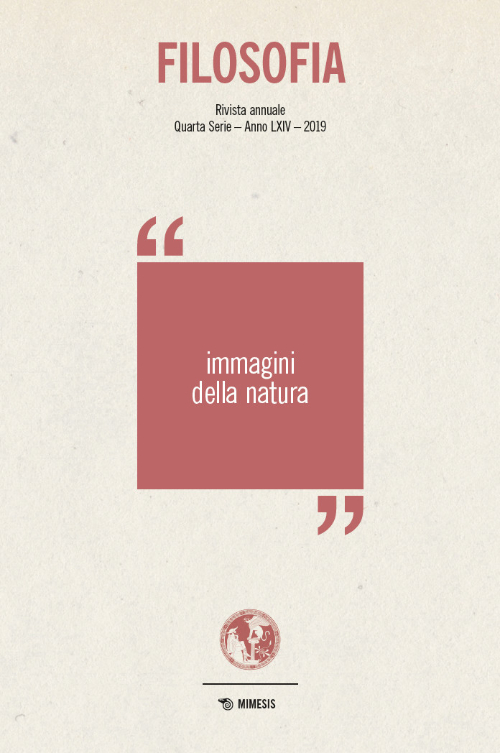To interpret and to represent nature. Charles Darwin and the life of plants
DOI:
https://doi.org/10.13135/2704-8195/4061Keywords:
Darwin, plants, life, nature, unityAbstract
The following essay aims to illustrate that Charles Darwin’s botanical researches are pivotal not only for botany itself, but especially for the interpretation of the whole nature. The life of plants, and not only the life of animals, shows Darwin principles and phenomena such as variation, natural selection and struggle for life. Moreover, the life of plants reveals aspects similar to the life of animals: for instance, the reproduction, the movement, some biochemical elements, a certain kind of perception, the evaluation, the discernment. These traits can be considered as a proof of the theory of common descent with modification, which affirms the unity of life through the diversity of living beings. On the one hand, the life of plants helps Darwin to understand nature, while on the other hand it represents the whole nature, whose living beings are “all netted together”. Therefore, to symbolize nature, Darwin draws a tree, the tree of life.
Downloads
References
A. Alpi et al., Plant neurobiology: no brain, no gain?, in “Trends in Plant Science”, 12 (2007), n. 4, pp. 135-136
P. Ayres, The aliveness of plants: the Darwins at the dawn of plant science, London, Pickering and Chatto, 2008
F. Baluŝka, S. Lev-Yadun, S. Mancuso, The ‘Root-Brain’ Hypothesis of Charles and Francis Dar-win: Revival after More Than 125 Years, in “Plant Signaling and Behavior”, 4 (2009), n. 12, pp. 1121-1127
F. Baluŝka, S. Lev-Yadun, S. Mancuso, Swarm Intelligence in Plant Roots, in “Trends in Ecology and Evolution”, 25 (2010), n. 12, pp. 682-683
D. Chamovitz, Quel che una pianta sa. Guida ai sensi nel mondo vegetale (2012), tr. it. di P. L. Gaspa, Milano, Raffaello Cortina Editore, 2013
E. Coccia, La vita delle piante. Metafisica della mescolanza (2016), Bologna, il Mulino, 2018
G. Cristofolini, Darwin e l’evoluzione delle piante. Nota introduttiva, in Il giardino di Darwin. L’evoluzione delle piante, a cura di G. Cristofolini e A. Managlia, Torino, Umberto Allemandi & C., 2009
C. Darwin, Autobiografia (1809-1882) (1958), a cura di N. Barlow, tr. it. di L. Fratini, prefazione di G. Montalenti, nuova introduzione di G. Giorello, Torino, Einaudi, 2006(3)
C. Darwin, Viaggio di un naturalista intorno al mondo (1839), a cura di P. Costa, tr. it. di M. V. Talluri, Milano, Feltrinelli, 2010(3)
C. Darwin, L’origine delle specie (1859), a cura di G. Pancaldi, Milano, Rizzoli, 2010(3)
C. Darwin, Le espressioni delle emozioni nell’uomo e negli animali (1872), con introduzione, postfazione e commenti di P. Ekman, con un saggio di P. Prodger, tr. it. di F. B. B. Baranelli e I. C. Blum, Torino, Bollati Boringhieri, 2012(3)
C. Darwin, Le piante insettivore (1875), a cura di G. Canestrini e P. A. Saccardo, Torino, UTET, 1878
C. Darwin, I movimenti e le abitudini delle piante rampicanti (1875), a cura di G. Canestrini e P. A. Saccardo, Torino, UTET, 1878
C. Darwin, F. Darwin, Il potere di movimento nelle piante (1880), tr. it. di G. e R. Canestrini, Torino, UTET, 1884
C. Darwin, I diversi apparecchi col mezzo dei quali le orchidee vengono fecondate dagli insetti (1862), tr. it. di G. Canestrini e L. Moschen, Torino, UTET, 1883
C. Darwin, L’azione dei vermi nella formazione del terriccio vegetale con osservazioni sulle loro abitudini (1881), a cura di G. Scarpelli, tr. it. di M. Graffi, Milano-Udine, Mimesis, 2012
C. Darwin, Capacità mentali e istinti negli animali (1975), a cura di A. Attanasio, Torino, UTET Università, 2011
F. Darwin, The botanical work of Darwin, in “Annals of Botany”, 13 (1899), pp. 9-19
F. Darwin, The Address of the President of British Association for the Advancement of Science, in “Science”, 28 (1908), n. 716, pp. 360-361
S. De Chadarevian, Laboratory Science versus Country-House Experiments. The Controversy between Julius Sachs and Charles Darwin, in “The British Journal for the History of Science”, 29 (1996), n. 1, pp. 17-41
A. Desmond, J. Moore, Darwin (1991), tr. it. di D. Mezzacapa, L. Talarico, A. Comba e A. Colombo, Torino, Bollati Boringhieri, 2012
N. Eldredge, Darwin. Alla scoperta dell’albero della vita (2006), tr. it. di S. Frediani, Torino, Codice edizioni, 2006
R. Firn, Plant intelligence: an alternative point of view, in “Annals of Botany”, 93 (2004), n. 4, pp. 345-351
A. Hodges, Root decisions, in “Plant Cell Environ”, 32 (2009), n. 6, pp. 628-640
S. D. Hopper, H. Lambers, Darwin as a plant scientist: a Southern Hemisphere perspective, in “Trends in Plant Science”, 30 (2009), n. 10
S. Finzi, Sul monte della preda, Bergamo, Moretti&Vitali Editori, 2004
D. Kohn, G. Murrell, J. Parker, M. Whitehorn, What Henslow taught Darwin, in “Nature”, 436 (2005), pp. 643-645
D. Kohn, Darwin’s garden: an evolutionary adventure, New York, The New York Botanical Garden, 2008
W. L. Lindsay, Mind in plants, in “British Journal of Psychiatry”, 21 (1876), n. 96, pp. 513-532
S. Mancuso, A. Viola, Verde brillante. Sensibilità e intelligenza del mondo vegetale, Firenze, Giunti, 2013
S. Mancuso, Farfalle e altre storie di famiglia, in S. Mancuso, Uomini che amano le piante. Storie di scienziati del mondo vegetale, Firenze, Giunti, 2014, pp. 57-58
E. Mayr, Un lungo ragionamento. Genesi e sviluppo del pensiero darwiniano (1991), tr. it. di F. B. Bandinelli, Torino, Bollati Boringhieri, 1994
T. Pievani, Il corallo della vita: il Taccuino B, in C. Darwin, Taccuini (1836-1844) (1987), ed. it. a cura di T. Pievani, prefazione di N. Eldredge, tr. it. di I. C. Blum, Roma-Bari, Laterza, 2008
T. Pievani, Introduzione a Darwin, Roma-Bari, Laterza, 2012
L. Repici, Uomini capovolti. Le piante nel pensiero dei Greci, Roma-Bari, Laterza, 2000
V. B. Smocovitis, Darwin’s botany in the Origin of Spe-cies, in M. Ruse, R. J. Richards, The Cambridge companion to the “Origin of Species”, Cambridge, Cambridge University Press, 2009
A. Trewavas, Aspects of plants intelligence, in “Annals of Botany”, 92 (2003), n. 1, pp. 1-20



